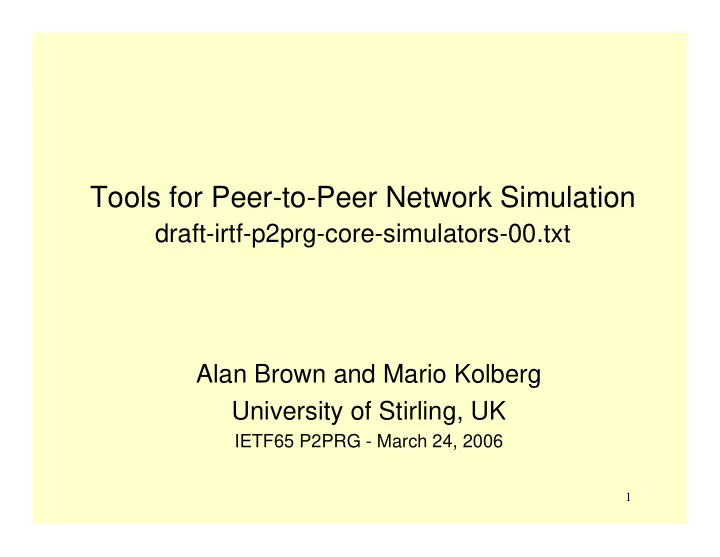

Tools for Peer-to-Peer Network Simulation draft-irtf-p2prg-core-simulators-00.txt Alan Brown and Mario Kolberg University of Stirling, UK IETF65 P2PRG - March 24, 2006 1
Overview • Provide survey of tools to P2P research community – Simulators and topology generators • Goal – Share experiences – Improve tools • increased scalability – Add new models for P2PRG Core group use • Note – We have not tested these tools – Only reporting what tool authors provide – Feedback welcomed! 2
Outline • Overlay Network Simulators • Packet-level Network Simulators • Topology generators 3
Packet level vs Overlay sim. • P2P overlay networks need to be scalable • Experimenting with large networks is important • Memory constraints • Level of detail in simulations • Distributed simulations • Multi-processor architectures • Topology Generators 4
Narses • http://sourceforge.net/projects/narses • Flow-based network simulator • Simulated aggregated flows rather than individual packets → reduce the number of events/memory requirements • Assumes available bandwidth on the first link for the remaining ones • Largest model found consists of 600 nodes transmitting 200kB flows of data • No evidence found of existing overlay networks models 5
3LS • Simulator is separated into three models – Network (Describes distance between nodes) – Protocol (Describes the P2P protocol used) – User (User input via GUI or file) • Some models exist in a library • Gnutella 0.4 model exists, but only with 20 nodes • To get simulator email authors: Nyik Ting (nyt431@mail.usask.ca) and Ralph Deters (deters@cs.susask.ca) 6
P2PSim • http://pdos.csail.mit.edu/p2psim • Event Simulator, multi-threaded • Supports Chord, Accordion, Koorde, Kelips, Tapestry, Kademlia • Tested with up to 3000 nodes using Chord 7
NeuroGrid • http://sourceforge.net/projects/neurogrid • Event Simulator, single threaded • Designed for file sharing systems • Simulations exists for Gnutella, Freenet, Pastry • Can simulate up to 300,000 nodes on a 4GB PC 8
PlanetSim • http://ants.etse.urv.es/planetsim • Splits simulations into overlay networks and their services • Services can be re-used for other overlay networks • Chord and Symphony simulations exists • Simulations can consist up to 100,000 nodes 9
PeerSim • http://sourceforge.net/projects/peersim • Offers predefined models for P2P simulation – OverStat (aggregation protocols to provide statistical information on network) – SG-1 (self organising and maintaining a superpeer based topology) – T-Man (used to built topologies using a ranking function defining the preference of each node for neighbours) • Two simulation engines (cycle and event based), cycle based engine does not consider transport layer • 1,000,000 nodes possible with cycle engine 10
Omnet++ • http://www.omnetpp.org • Open source • Mainly used for network simulations, but also for queuing networks, and multiprocessors • GUI • Available models: TCP, UDP, IP, Ethernet, MPLS, RSVP, 802.11 • P2P swarming simulation exists with 1000 nodes • Can run distributed simulations across a number of machines 11
NS2 • http://www.isi.edu/nsnam/ns • Discrete event network simulator • Supports many network protocols, multicasting, MAC layer protocols • Consists of many packages • Large community of users, but little work in ns2 for P2P reported • Protocols are implemented in C++, networks in OTcl • One P2P simulation exists (Gnutella) 12
SSFNet • http://www.ssfnet.org • Java and C++ APIs – Java is commercial version free to universities – Now unsupported though • Hosts are described by deriving from base classes • DML is used for configuration of networks • Parallel simulations on multiprocessor PC possible • Supports Windows/Linux/Solaris • Network sizes of 33,000 nodes have been achieved 13
Georgia Tech Network Simulator • GTNets allows to define nodes, links, bandwidth, applications • Supports layer 2 (802.3/802.11), IP, TCP, UDP • Simulations may be animated • Good scalability with network sizes up to 480,000 nodes 14
Summary SIMULATOR P2P PROTOCOLS MAX NODES DISTRIBUT SIMULATIO Narses None 600 No 3LS Gnutella < 1,000 No NeuroGrid Gnutella, NeuroGrid, 300,000 No Pastry, FreeNet PeerSim Collection of > 10^6 No internally developed P2P models P2PSim Chord, Accordion, 3,000 No Koorde, Kelips, Tapestry, Kademlia. Omnet++ None 1,000* Yes NS2 Gnutella N/A Yes SSFNet None 33,000 Yes 15
Topology Generators • Generate networks with certain characteristics, based on sampled network traffic • Especially useful for large networks • Packet-level simulators • Brite – Topologies based on RouterWaxman and RouterBarabasiAlbert models • GT-ITM – Generates flat random graphs and also hierachical graphs • INET – Generates autonomous system level network models which do not contain information on bandwidth, traffic, latency • TIERS – Generates structured, hierachical models reproducing LANs, MANs and WANs 16
Topology Generators Generator Input-Formats Output-Formats Supported Simul. GT-ITM, INET, DML, Brite, Otcl, NS2, Omnet++, Brite NLANR-AS NED SSFNet GT-ITM, Otcl*, DML*, Omnet++*, NS2, P2PSim, GT-ITM n/a NED* SSFNet, GTNets INET, Otcl*, DML*, NS2, Omnet++, INET n/a NED* SSFNet TIERS n/a Otcl* NS2 17
Next Steps • Update the draft based on – New tools available – Experience reports from P2PRG community • Comments? 18
Recommend
More recommend